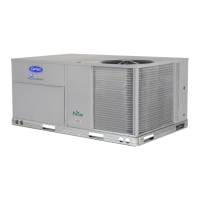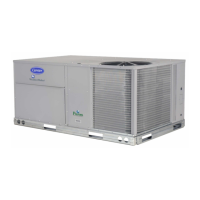56
A redline command or loadshed command will stay in effect
until a Cancel redline or Cancel loadshed command is re-
ceived, or until the configurable Maximum Loadshed time
(SH.TM) has elapsed.
HEAD PRESSURE CONTROL
Condenser head pressure for the 48/50P Series is managed di-
rectly by the ComfortLink controls. The controls are able to cy-
cle up to 6 stages of outdoor fans to maintain acceptable head
pressure. Fan stages will be turned on or off in reaction
to discharge pressure sensors with the pressure converted to the
corresponding saturated condensing temperature.
An option to allow fan speed control (Motormaster
®
) on the
first stage is configured by setting Configuration
COOL
M.M = Yes.
There are three configurations provided for head pressure con-
trol that can be found at the local display:
Configuration
COOL
M.M (MotorMaster enable)
Configuration
COOL
SCT.H (Maximum Condensing
Temp)
Configuration
COOL
SCT.L (Minimum Condensing
Temp)
There are up to four outputs provided to control head pressure:
Outputs
FANS
CDF.1 — Condenser Fan Output 1
Outputs
FANS
CDF.2 — Condenser Fan Output 2
Outputs
FANS
CDF.3 — Condenser Fan Output 3
Outputs
FANS
CDF.4 — Condenser Fan Output 4
The specific staging sequence for a unit depends on the 3 fac-
tors: the unit size (tonnage), which refrigeration circuits are
currently operating, and whether or not MotorMaster is en-
abled. See Fig. 7 for fan staging sequencing.
The condenser fan output controls outdoor fan contactors and
outdoor fans for each unit tonnage as shown in Fig. 7. Each
stage of fans is also shown. The ComfortLink controller adds
or subtracts stages of fans based on SCT.H and SCT.L. When
the SCT rises above SCT.H, a fan stage will be added. The
ComfortLink controller will continue to add a fan stage every
10 seconds thereafter if the SCT remains above SCT.H. If SCT
rises above 130°F, the controller will turn on the maximum fan
stages for the unit. When the SCT drops below the SCT.L, a
fan stage will be subtracted. The ComfortLink controller will
continue to drop a fan stage every 2 minutes thereafter if the
SCT remains below SCT.L.
When a condenser fan output is common to both refrigeration
circuits (in other words, when the fan(s) will affect both circuit
A and circuit B), the following logic is used: in order to add a
fan stage, the SCT of either circuit must be above SCT.H for
30 seconds and in order to subtract a stage, the SCT of both cir-
cuits must be below SCT.L for 30 seconds.
Whenever the outdoor ambient temperature (OAT) is above
70°F, the maximum stage will always be on when the compres-
sors are on.
On the initial start-up of a circuit, the condenser fans will start
5 seconds prior to the compressor starting in order to ensure
proper head pressure of the compressor immediately at start-
up. After the compressor starts, the normal head pressure rou-
tine will begin 30 seconds after the condenser fan pre-start.
What stage fans starts depends on the outdoor ambient tem-
perature. The three situations are:
OAT <
50°F
50°F < OAT < 70°F
OAT >
70°F
See Fig. 7 for what stage of fans starts for each scenario.
ECONOMIZER INTEGRATION WITH MECHANICAL
COOLING
When the economizer is able to provide free cooling (Run Sta-
tus
ECON
ACTV = YES), mechanical cooling may be de-
layed or even held off indefinitely.
NOTE: Once mechanical cooling has started, this delay logic is no
longer relevant.
Multi-Stage Cooling Economizer Mechanical Cooling Delay
This type of mechanical cooling delay is relevant to the follow-
ing machine control types:
C.TYP = 1 VAV-RAT
C.TYP = 2 VAV-SPT
C.TYP = 3 TSTAT-MULTI
C.TYP = 4 SPT-MULTI
If the economizer is able to provide free cooling at the start of a
cooling session, the mechanical cooling algorithm (SumZ), checks
the economizer’s current position (Run Status
ECON
ECN.P) and compares it to the economizer’s maximum position
(Configuration
ECON
EC.MX) – 5%. Once the economizer
has opened beyond this point, a 150 second timer starts. If the
economizer stays beyond this point for 2.5 minutes continuously,
the mechanical cooling algorithm is allowed to start computing
demand and stage compressors and unloaders.

